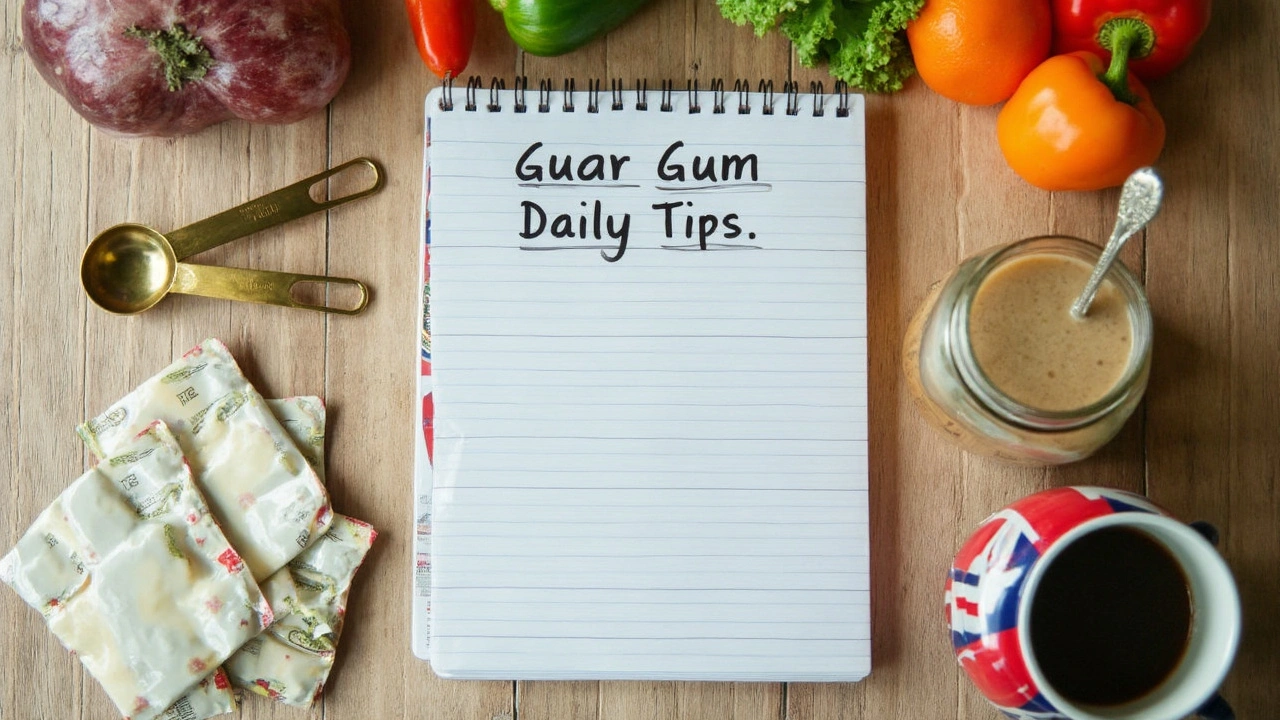Think you know all the best ways to get more fiber? Most people skip over guar gum, but it’s actually one of the easiest—and sneakiest—tools for a healthier gut and smoother digestion. You’ll find it tucked away in tons of foods, from your favorite gluten-free bread to low-cal ice cream. But you don’t have to be a chef or a scientist to use it at home.
Here’s the deal: guar gum isn’t just some weird additive; it’s a natural fiber from the guar bean that does double duty. It helps foods stick together and makes them creamy while also giving your body the fiber punch it craves. The best part? You barely notice it’s there.
If you struggle with staying regular, crave something that keeps you fuller, or need an easy way to support blood sugar balance, guar gum deserves a spot on your radar. You don’t need big, complicated changes—just a little powder in a smoothie or a sprinkle in homemade soup. Curious how that works and if it’s really worth trying? Stick around, and you’ll get the lowdown, plus a few tips to make guar gum work for you—not against you.
- What Is Guar Gum and Where Does It Come From?
- Surprising Health Benefits Backed by Science
- Smart Ways to Add Guar Gum to Your Diet
- Potential Side Effects and Things to Watch For
- Tips for Picking Quality Guar Gum Products
What Is Guar Gum and Where Does It Come From?
First off, guar gum comes straight from the guar bean—a crop that’s easy to grow and has been part of farming culture in India and Pakistan for ages. Picture small green beans hanging on shrubby plants. Most of the world’s supply comes from those two countries, where farmers have been harvesting and processing guar beans for decades.
The magic happens inside the bean itself. There’s a part called the endosperm, which is basically the bean’s starchy middle. That’s where all the good stuff sits. When you grind up this middle part and dry it, you get guar gum powder: a fine, off-white powder that’s loaded with fiber. It doesn’t have a taste, which means it can slip into recipes or commercial foods without being noticed.
So why is guar gum getting so much attention? This stuff is a powerhouse when it comes to thickening things up. A tiny bit can turn a watery soup into something hearty, or make gluten-free doughs work like regular ones. In the food world, it’s been used for decades in ice cream, yogurt, sauces, and even tortillas—because it helps keep things smooth, stretchy, and moist.
Check this out—guar gum isn’t just popular in the kitchen. Because it’s such a great thickener and stabilizer, manufacturers use it in a bunch of other products too. We’re talking toothpaste, shampoo, even tablets and pills. But when it comes to boosting your diet with some extra fiber, the food-grade version is what matters most.
| Top Guar Bean-Producing Countries | Percent of World Supply |
|---|---|
| India | ~80% |
| Pakistan | ~15% |
| Others | ~5% |
The main thing to remember: Guar gum is natural, comes from a legume, and slips into all kinds of foods to make them better or healthier. It’s not just for industrial food makers—anyone can use it at home, and you don’t need to be an expert to give it a try.
Surprising Health Benefits Backed by Science
Guar gum may look simple, but it pulls its weight when it comes to health perks. Researchers have found that adding more guar gum to your diet can seriously boost your daily fiber intake. Since it’s a soluble fiber, it works in your gut by soaking up water and turning into a gel. This helps things move along smoothly, making it a favorite for folks who want to stay regular without reaching for over-the-counter laxatives.
What really gets scientists talking is guar gum’s link to blood sugar control. One study out of the American Journal of Clinical Nutrition found that just 10 grams of guar gum per day, split between meals, helped people with type 2 diabetes keep their blood sugar from spiking after eating. That’s a big reason it’s showing up in more dietary supplement lists for blood sugar support.
If you’re focused on weight management, here’s something to chew on: guar gum helps you feel full, fast. Why? That gel it forms in your stomach makes you less likely to snack or overeat later. In a clinical trial, people who had foods thickened with guar gum felt fuller and ate fewer calories at their next meal. This makes it a sneaky but smart hack for folks watching their weight or cravings.
On top of that, guar gum supports gut health by feeding the good bacteria in your digestive system. This “prebiotic” effect means you’re giving your microbiome more of what it wants, which helps with everything from bloating to better immunity.
| Benefit | Science Says |
|---|---|
| Digestive regularity | Improves stool frequency & consistency in healthy adults |
| Blood sugar support | Lowers post-meal glucose spikes in people with type 2 diabetes |
| Weight management | Boosts satiety and helps reduce overall calorie intake |
| Gut health | Acts as a prebiotic, fueling helpful gut bacteria |
If you already try to eat more veggies and whole grains for fiber but still struggle, adding guar gum can be an easy fix. Just be sure to start slow—fiber works best with plenty of water and a gradual bump-up to avoid bloating. Stick with it and your gut will thank you.

Smart Ways to Add Guar Gum to Your Diet
Add guar gum to your meals, and suddenly you’re boosting your fiber without even thinking about it. Since it’s flavorless and you only need a tiny bit, you can slide it into recipes where nobody will notice—except your gut, which will thank you later.
If you want to start simple, just toss a quarter teaspoon into your morning smoothie. It thickens things right up and gives you a creamy texture that’s almost dessert-like. Baking gluten-free? Guar gum works like magic for holding breads and cakes together—mix it into your flour blend at about ½ teaspoon per cup of flour. For homemade salad dressings, sprinkle a pinch and give it a whisk; your dressings will stay mixed and have a smooth feel.
Here are practical ways to get more dietary supplement power from guar gum:
- Smoothies & Shakes: Add 1/4 teaspoon to protein shakes or morning smoothies for extra fiber and thickness.
- Homemade Baked Goods: Use as a binder in gluten-free baking. A small amount (1/4 to 1/2 teaspoon per cup of flour) keeps things moist and less crumbly.
- Soups & Sauces: Sprinkle a teaspoon while cooking to thicken without cream or heavy starches.
- Ice Cream & Yogurt: Blend 1/4 teaspoon when making homemade frozen treats for that professional creamy texture.
- Low-Carb Cooking: Swap out wheat thickeners for guar gum in recipes like keto gravy or sugar-free jelly.
Don’t go overboard: guar gum is strong stuff. Too much can lead to an upset stomach or a weird, gummy texture in food. Start small and work your way up. And always mix it in well, since it clumps if you add it straight to cold liquids without stirring.
Here’s a quick look at how much guar gum to use in common recipes:
| Food Type | Suggested Amount |
|---|---|
| Smoothies/Shakes | 1/4 teaspoon per 16 oz |
| Baked Goods (Gluten-Free) | 1/2 teaspoon per cup flour |
| Soups/Sauces | 1 teaspoon per quart |
| Ice Cream/Yogurt | 1/4 teaspoon per quart |
In short, guar gum blends right in and saves you from spending on fancier, less effective fiber supplements. You get better textures, fewer calories, and that gut-healthy boost, all with almost zero effort.
Potential Side Effects and Things to Watch For
Before you start scooping guar gum into everything, let’s get real about what could go wrong. Most people handle it fine, but going overboard can lead to some not-so-fun surprises—especially if your body isn’t used to loads of fiber.
The most common issues? Think bloating, gas, or a bit more time in the bathroom than you were planning. If you suddenly start taking lots of fiber from guar gum, don’t be shocked if your belly feels unsettled. Easing it in slowly helps your gut figure things out.
Here’s a quick look at common side effects and the best ways to avoid trouble:
- Bloating or Gas: Go slow when adding guar gum to your diet, especially if you’re new to fiber supplements.
- Loose Stools: Too much too soon can set off a dash to the bathroom. Start with a tiny amount and increase gradually.
- Choking Risk: Never eat guar gum dry—always mix it fully with liquid. It swells fast, so your throat and stomach need it to be mixed in well.
- Drug Interactions: Guar gum can slow how fast your body soaks up medicine or supplements. Take your meds at a different time if you use guar gum daily.
Dr. Michael Greger, author and physician, puts it bluntly:
“With any concentrated fiber supplement like guar gum, start low and go slow—your gut will thank you for it.”
Rarely, some folks can have allergic reactions. If you notice hives, trouble breathing, or your throat feels tight, stop using it and call your doctor.
The right dose makes all the difference. Most research suggests 5 to 15 grams a day for dietary supplement use is safe, but everyone’s gut is different. A little can go a long way—so don’t assume more is better.
| Daily Amount | Possible Effect |
|---|---|
| Under 5g | Usually well tolerated |
| 5-10g | Some may feel mild bloating |
| 15g+ | Increased risk of GI discomfort or diarrhea |
If you have any medical conditions—especially with your gut, like IBS—check in with a doctor before adding guar gum to your regular diet. Better safe than sorry.

Tips for Picking Quality Guar Gum Products
Not all guar gum products are the same. Some are made for food, some for industrial use, and only a handful are actually safe and clean for your kitchen. So, what should you look for?
- Check the label for food-grade guar gum. You want to see "food-grade" right on the packaging. Industrial guar gum is not made for eating and can have unwanted stuff in it.
- Go organic if you can. Organic guar gum usually comes from beans that haven’t been sprayed with weird chemicals. It’s just a safer bet if you're picky about what's in your pantry.
- Pick brands with simple ingredient lists. All you need is "guar gum" on that side panel—no fillers, weird starches, or mystery additives.
- Look for allergen-free certifications. If you have food sensitivities, check for products labeled gluten-free, non-GMO, or allergen-free. These can help you avoid hidden tummy troubles later.
- Find fine powder, not clumps. A good quality guar gum is a soft, white powder (not grainy or chunky). This kind dissolves better and gives you the best results in your recipes.
If you’re a numbers guy, here's a quick breakdown of what top sellers offer:
| Brand | Type | Organic | Allergen-Free |
|---|---|---|---|
| NOW Foods | Food Grade | No | Gluten-Free |
| Anthony’s | Food Grade | Yes | Non-GMO, Gluten-Free |
| Bob’s Red Mill | Food Grade | No | Gluten-Free |
Don’t pay extra for a fancier-looking jar—the real value is in the ingredient quality. And if you have a sensitive stomach, start with smaller amounts to see how your body handles it. That way, you can get all the dietary supplement perks without any surprises.







Tammy Cooper
April 29, 2025 AT 07:48so i tried guar gum in my morning smoothie and let me tell you... my gut went full chaos mode. like, i thought i was being healthy but nope, it was like a swamp in there. start slow, folks. i did a full tsp and now i’m questioning all my life choices.
Cameron Perry
April 29, 2025 AT 12:01wait so it’s just fiber but invisible? that’s wild. i’ve been using psyllium husk for years and it’s like chewing sand. this sounds like the cheat code for fiber without the texture trauma. gonna try a quarter tsp in my oatmeal tomorrow.
Alyssa Hammond
April 30, 2025 AT 18:57you people are so naive. guar gum isn’t a ‘natural fiber’-it’s a corporate tool disguised as wellness. big food uses it to make junk look healthy while they strip out real nutrients. they don’t care if you’re bloated-they care if you keep buying their ‘gluten-free’ $8 bread that tastes like cardboard and feels like a brick in your stomach. this is capitalism feeding you fiber like a pacifier.
and don’t get me started on the ‘prebiotic’ hype. your gut bacteria don’t care if it’s guar gum or oat bran-they care if you eat real food. stop treating supplements like magic dust. you’re not fixing your microbiome with powder. you’re just paying for placebo with a fancy label.
and yes, i’ve read the studies. they’re all funded by food conglomerates. the real science says whole foods, period. no powder. no gimmicks. just broccoli. and if you can’t handle broccoli, maybe you need therapy, not guar gum.
Jill Amanno
May 2, 2025 AT 09:49guar gum is just another symptom of our broken relationship with food. we’ve outsourced digestion to chemicals because we’re too lazy to chew. we want the benefit without the effort, the fiber without the whole plant, the health without the responsibility. we don’t want to grow food or even cook it-we want to sprinkle magic dust and call it wellness.
this isn’t nutrition. it’s spiritual bypassing with a powder shaker. you think you’re healing your gut but you’re just feeding your addiction to convenience. the real question isn’t ‘how much guar gum?’-it’s ‘why are we so terrified of real food?’
and yes, i’ve eaten raw guar beans. they’re bitter. they’re earthy. they’re alive. and they didn’t come in a plastic bag with a ‘food-grade’ sticker.
Kelley Akers
May 4, 2025 AT 00:24i mean, if you’re going to use a food additive, at least make sure it’s organic, non-gmo, and cold-processed. i saw someone on instagram using grocery store guar gum from a bulk bin and i nearly had a stroke. you wouldn’t put industrial glue in your coffee, so why put industrial-grade gum in your smoothie? it’s not just about fiber-it’s about integrity. if you’re going to ‘optimize’ your diet, do it right. or don’t bother.
Peggy Cai
May 4, 2025 AT 04:02guar gum is the quiet revolution of modern digestion nobody talks about because everyone’s too busy chasing probiotics and kale smoothies to notice the silent hero in their gluten-free bread
it’s not about being trendy it’s about being smart
your gut doesn’t care about your instagram bio
it just wants to move
and guar gum lets it move without drama
stop overthinking it
just use it
and stop judging people who don’t know the difference between food grade and industrial
you’re not a nutrition priest
you’re just loud
Taylor Smith
May 5, 2025 AT 22:11just tried it in my homemade tomato soup-1 tsp, mixed into a little water first-and wow. it thickened it perfectly without cream. no weird aftertaste, no lumps. my partner didn’t even notice, just said ‘this soup feels richer.’ i’m sold. thanks for the tip.
Kate Calara
May 6, 2025 AT 14:29you know guar gum is made from beans grown in india and pakistan right? and now you’re putting it in your smoothie like it’s some sacred wellness ritual? what if the beans were sprayed with pesticides? what if the processing plant uses chemicals that leach into the powder? what if it’s mixed with fillers from china? you think the label says it all? please. the food industry hides more than it reveals. i’ve seen the factory videos. it’s not ‘natural’-it’s a chemical dance you’re too distracted to notice.
and don’t get me started on the ‘gluten-free’ scam. they put guar gum in everything to make it stick together so you think you’re eating healthy. you’re not. you’re eating a ghost of food.
your gut isn’t healing. it’s being manipulated.
Chris Jagusch
May 7, 2025 AT 14:38in nigeria we use ogiri and ugba for thickening not this american powdered nonsense. guar gum is for people who lost touch with real food. our grandmothers used okra slime and ground melon seeds-real, alive, no plastic bags. you think your ‘fiber boost’ is better? you’re just addicted to convenience. go back to your roots. or at least eat something that didn’t cross an ocean to sit in your blender.
Phillip Lee
May 8, 2025 AT 01:33the science is solid. soluble fiber slows glucose absorption. guar gum does that better than most. stop the drama. if you’re bloated, you’re using too much. use 5g max. drink water. problem solved. this isn’t philosophy. it’s physiology.
Nancy N.
May 8, 2025 AT 12:46hey i tried it in my coffee yesterday and i think i accidentally swallowed it dry and now i feel like my throat is full of glue… please tell me im not dying
Tammy Cooper
May 8, 2025 AT 14:07oh my god i told you. never eat it dry. it swells in your throat like a sponge. drink water immediately. you’re fine. just don’t do that again. maybe try mixing it in a shaker bottle next time?
Shivani Tipnis
May 9, 2025 AT 04:07guar gum is the future of affordable fiber for the masses. why pay $30 for a supplement when you can get 500g for $12 and put it in everything? if you’re still using expensive powders with 12 ingredients you can’t pronounce you’re doing it wrong. this is the real deal. simple. clean. effective. stop overcomplicating wellness
Cindy Fitrasari S.
May 9, 2025 AT 12:11i’ve been using it for 3 months now. no drama. just regular bowel movements and less afternoon cravings. i don’t need to make it a movement or a lifestyle. it just works. i’m not trying to be a hero. i just want to feel okay.